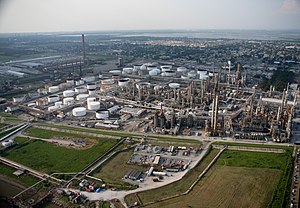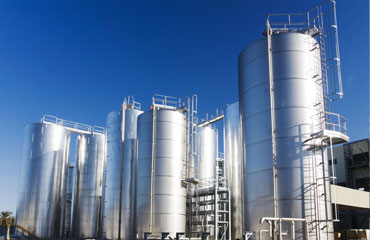Modern-Day Metalworking: Examining Cutting Tools Technology
 Metalworking has grown by leaps and bounds with the latest in manufacturing technology. Cutting tools and machining processes have evolved to the point where industrial equipment can be made faster and at lesser expense than ever before. These end products are used in every facet of life from the home to the office and in essentially every industry and market. The end result of these advances is to make the manufacturing sector competitive in the global marketplace by providing precision products at the lowest price.
Metalworking has grown by leaps and bounds with the latest in manufacturing technology. Cutting tools and machining processes have evolved to the point where industrial equipment can be made faster and at lesser expense than ever before. These end products are used in every facet of life from the home to the office and in essentially every industry and market. The end result of these advances is to make the manufacturing sector competitive in the global marketplace by providing precision products at the lowest price.
New technologies focus on refining overall production processes. The best way to do so is to combine multiple process steps into one machining operation. Every time materials have to be switched between machines, there is lost time due to loading and unloading along with repositioning and workholding. New working materials and processes helps accomplish the reduction in working steps required for precision products.
Hard Turning And Milling Operations
A common bottleneck in working with hard metals was the need for intermediate working steps. For example, if the cutting tools in use were not capable of working a hard metal, that metal would have to be worked and then heat treated to its final hardness, requiring additional finishing and grinding steps afterward. For example, industrial equipment made from high hardness materials would be worked in an annealed condition and then would be heat treated, requiring further grinding and finishing.
Today’s hard turning machine steps are able to avoid all of that intermediate work. Specialized cutting tools made from polycrystalline cubic boron nitride can turn and mill hardened materials without an annealing step to lower hardness. This particular metalworking breakthrough imparts a number of highly desirable properties into machine components: high toughness, chemical stability, high hardness and high thermal conductivity along with a low thermal expansion coefficient. By removing entire working steps, finished products can come off the line cheaper, faster, and with fewer flaws or off specification rejects.
Hard turning can also supplant grinding in some cases. When this applies, hard turning runs faster than grinding, again lowering both run times and costs.
High Speed Cutting Tools
Many high speed processes were reserved for softer metals as well, such as aluminum. The same issue with annealing and heat treatment also applied for this type of metalworking. But just like turning, new high speed cutting tools can handle harder metals without the intermediate process steps. Again, today’s technology is focused on reducing the per unit cost of all types of industrial equipment.
It might seem counterintuitive, but speeding up metalworking processes actually generates high precision products. Each new step introduces a chance for error, either in part due to human infor industry verticals mistakes, improper workholding, machines working outside of specifications, and over working. The ability to cut out intermediate work has a noticeable impact on quality control.
Safety And Reliability – Dry Machining
The polycrystalline cubic boron nitride material’s properties also preclude the need for cooling fluids. This is accomplished due to the ability of the …






 No matter how nice of a place you might have for yourself or your business, you never have any guarantee that you won’t potentially suffer from an incident such as a fire outbreak that can wreak some serious havoc on the place and potentially endanger everyone in there. There’s a lot you can do to ensure that in the event that this happens, you can react appropriately though – and all it takes is a little bit of research, some money to invest into the right products, and a good partner company that’s experienced with the market for these things.
No matter how nice of a place you might have for yourself or your business, you never have any guarantee that you won’t potentially suffer from an incident such as a fire outbreak that can wreak some serious havoc on the place and potentially endanger everyone in there. There’s a lot you can do to ensure that in the event that this happens, you can react appropriately though – and all it takes is a little bit of research, some money to invest into the right products, and a good partner company that’s experienced with the market for these things. Buying fire safety devices like a fire alarm bell is a far cry from shopping for regular things like food or clothes. When you go to the mall to shop for food items or clothing, you just go from rack to rack to see what you like and then get whatever it is that you think would be of good use to you. It is not the same thing with fire safety devices. You just cannot take a quick look and grab the first fire alarm bell you see on the store shelf. You need to spend time to learn about their features and test the quality and performance; and, of course, to find a reputable fire alarm bell supplier that will steer you towards a durable and efficient product.
Buying fire safety devices like a fire alarm bell is a far cry from shopping for regular things like food or clothes. When you go to the mall to shop for food items or clothing, you just go from rack to rack to see what you like and then get whatever it is that you think would be of good use to you. It is not the same thing with fire safety devices. You just cannot take a quick look and grab the first fire alarm bell you see on the store shelf. You need to spend time to learn about their features and test the quality and performance; and, of course, to find a reputable fire alarm bell supplier that will steer you towards a durable and efficient product. When it comes to fire safety, the most important aspect is having fire alarms and ensuring that they work. This is as true for the home as it is for the office or workplace and these alarms have to be tested on a regular basis. It is not enough to buy fire alarms, install them and leave them be. The point of a fire alarm is to provide as much warning as possible over a fire to allow action to be taken or the building to be evacuated as quickly as possible.
When it comes to fire safety, the most important aspect is having fire alarms and ensuring that they work. This is as true for the home as it is for the office or workplace and these alarms have to be tested on a regular basis. It is not enough to buy fire alarms, install them and leave them be. The point of a fire alarm is to provide as much warning as possible over a fire to allow action to be taken or the building to be evacuated as quickly as possible. Getting the best deals from an auction takes much more than the just being the highest bidder. There are many other things that must be taken into consideration in order to purchase something of great value such as industrial equipment. Just like every other business, the purchasing of industrial equipment requires an ability to sort the good from the bad. Otherwise, it would be very easy to buy sub-standard equipment whatever the price and not realize it until nothing can be done about it.
Getting the best deals from an auction takes much more than the just being the highest bidder. There are many other things that must be taken into consideration in order to purchase something of great value such as industrial equipment. Just like every other business, the purchasing of industrial equipment requires an ability to sort the good from the bad. Otherwise, it would be very easy to buy sub-standard equipment whatever the price and not realize it until nothing can be done about it. Since the first caveman etched a mammoth on the wall of his cave, humans have been finding ways to express the experience of living. Every culture in the world tells stories, makes up plays, sings songs and creates dance. Art in all of its forms is as part of the human genetic code. It is deep within us, a creative impulse that yearns to be expressed. Some believe the creative urge is biologically linked to our need to reproduce, that our survival depends on having creative impulses. It is in the creative impulse that we want to shape and nurture our young, and bring something beautiful into the world. Deeply tied into our biological drives, the need to create is as real as the need to eat, breath, sleep and dream. Everyone on the planet has the urge to create, in one form or another. For some, the darkest challenges life has turned this need into the urge to create chaos or harm to others. Still it is a creative urge that demands the world notice they exist. It is a powerful force and should be honored as such. Art belongs to everyone. Art supplies, like paints, colored pencils, clay, foam board, and crayons, are often a big part of a child’s life. It is easy to see the artist in a child. They may like building things, drawing, singing, or telling and listening to stories. Why to we treat our artistic impulses like clothes that we grow beyond?
Since the first caveman etched a mammoth on the wall of his cave, humans have been finding ways to express the experience of living. Every culture in the world tells stories, makes up plays, sings songs and creates dance. Art in all of its forms is as part of the human genetic code. It is deep within us, a creative impulse that yearns to be expressed. Some believe the creative urge is biologically linked to our need to reproduce, that our survival depends on having creative impulses. It is in the creative impulse that we want to shape and nurture our young, and bring something beautiful into the world. Deeply tied into our biological drives, the need to create is as real as the need to eat, breath, sleep and dream. Everyone on the planet has the urge to create, in one form or another. For some, the darkest challenges life has turned this need into the urge to create chaos or harm to others. Still it is a creative urge that demands the world notice they exist. It is a powerful force and should be honored as such. Art belongs to everyone. Art supplies, like paints, colored pencils, clay, foam board, and crayons, are often a big part of a child’s life. It is easy to see the artist in a child. They may like building things, drawing, singing, or telling and listening to stories. Why to we treat our artistic impulses like clothes that we grow beyond? As a new parent, one of the most important concerns you have is keeping your baby safe. Babies spend the majority of their time at home and this is where you will concentrate your efforts to ensure their safety.
As a new parent, one of the most important concerns you have is keeping your baby safe. Babies spend the majority of their time at home and this is where you will concentrate your efforts to ensure their safety. Choosing from such a vast selection of industrial supplies in the marketplace can render paralyzed at the best of times if you have no specific selection process to
Choosing from such a vast selection of industrial supplies in the marketplace can render paralyzed at the best of times if you have no specific selection process to  Polythene is a plastic made from petroleum (as are all plastic products by the way, they are just made from different combinations of petroleum and other chemicals to make more or less durable products). In the case of Polythene Sheeting you can get industrial density that can be used as a barrier between layers of your home or get very thin sheeting that can be used as drop cloths, furniture covers and so on.
Polythene is a plastic made from petroleum (as are all plastic products by the way, they are just made from different combinations of petroleum and other chemicals to make more or less durable products). In the case of Polythene Sheeting you can get industrial density that can be used as a barrier between layers of your home or get very thin sheeting that can be used as drop cloths, furniture covers and so on. Hiking is an enjoyable activity that can also be seen as a form of exercise. Those that love the outdoors and get bored at the gym may find it exciting to venture through the trails of a nearby mountain or forest. There are some hiking safety tips that should be known so that your trip will be as pleasing as possible. Read on to learn more about what you can do before and during your journey to stay safe.
Hiking is an enjoyable activity that can also be seen as a form of exercise. Those that love the outdoors and get bored at the gym may find it exciting to venture through the trails of a nearby mountain or forest. There are some hiking safety tips that should be known so that your trip will be as pleasing as possible. Read on to learn more about what you can do before and during your journey to stay safe. Modern racing has developed drastically from the early 1920s and 1930s competitions that included such legends as the Mercedes-Benz Silver Arrows. The story stands that in the 1930s cars had to undergo weight checks, similar to wrestling competitions. The Mercedes-Benz car was found to be 751 kg of the 750 kg limit. Who came up with the idea to sand
Modern racing has developed drastically from the early 1920s and 1930s competitions that included such legends as the Mercedes-Benz Silver Arrows. The story stands that in the 1930s cars had to undergo weight checks, similar to wrestling competitions. The Mercedes-Benz car was found to be 751 kg of the 750 kg limit. Who came up with the idea to sand  Getting a quote for services is the most basic of business practices. With electrical services however, it’s also a potentially tricky process. There’s a potential risk in terms of a range of issues, from specifications
Getting a quote for services is the most basic of business practices. With electrical services however, it’s also a potentially tricky process. There’s a potential risk in terms of a range of issues, from specifications  Whether you’re looking for beads for your own jewelry-making hobby or to sell to other hobbyists, there’s good reason to buy online. Actually, there are many good reasons to do that, as opposed to buying traditionally from a brick-and-mortar store. Whether you’re talking about plastic beads or gemstone beads or any other variety, there are three main benefits you can enjoy when you buy online.
Whether you’re looking for beads for your own jewelry-making hobby or to sell to other hobbyists, there’s good reason to buy online. Actually, there are many good reasons to do that, as opposed to buying traditionally from a brick-and-mortar store. Whether you’re talking about plastic beads or gemstone beads or any other variety, there are three main benefits you can enjoy when you buy online. Industrial surplus are the industrial equipments that were used by those companies that had to wrap up their organization because of insolvency or any other economical or relevant crisis. This crisis usually happens when an organization spends a particular amount of money to produce something, but later, after the production, they find that the produced goods will be unable to regain the spent amount of money. The machines that are sold by the industrial surplus shops are, in many cases, of good condition and good quality they are not usually obsolete or archaic. Rather, there is a benefit of choosing
Industrial surplus are the industrial equipments that were used by those companies that had to wrap up their organization because of insolvency or any other economical or relevant crisis. This crisis usually happens when an organization spends a particular amount of money to produce something, but later, after the production, they find that the produced goods will be unable to regain the spent amount of money. The machines that are sold by the industrial surplus shops are, in many cases, of good condition and good quality they are not usually obsolete or archaic. Rather, there is a benefit of choosing  Electrical maintenance contracts are often the source of irritation for many businesses. The standards of industrial electrical service can vary from excellent to not very good, and reliability is a natural issue. Good electrical maintenance contractors are in a very different league from the average. The best electrical maintenance contractors are easy to spot.
Electrical maintenance contracts are often the source of irritation for many businesses. The standards of industrial electrical service can vary from excellent to not very good, and reliability is a natural issue. Good electrical maintenance contractors are in a very different league from the average. The best electrical maintenance contractors are easy to spot. Profitability in the manufacturing business largely depends on the right equipment and sound industrial equipment advice. Investing in an industrial equipment is a major decision for any company and the owners and managers must know how to choose the right equipment at the right time in order to make the purchase worthwhile.
Profitability in the manufacturing business largely depends on the right equipment and sound industrial equipment advice. Investing in an industrial equipment is a major decision for any company and the owners and managers must know how to choose the right equipment at the right time in order to make the purchase worthwhile. Choosing the right pet shampoo from the variety of formulations available depends upon what you hope to achieve with its use, and what type of animal you own. Rather than
Choosing the right pet shampoo from the variety of formulations available depends upon what you hope to achieve with its use, and what type of animal you own. Rather than  Let us admit that sometimes, no one is left at home when everyone is at school or work. Sometimes, kids are left behind with the older children if both parents are working. But although your kids are at home, you still have to make sure that they are safe and far from any incidents. Burglary or theft and fire incidents are the most common nowadays, and as responsible parents, you have to make sure that your home is safe from it for you to be able to secure the safety of your family as well.
Let us admit that sometimes, no one is left at home when everyone is at school or work. Sometimes, kids are left behind with the older children if both parents are working. But although your kids are at home, you still have to make sure that they are safe and far from any incidents. Burglary or theft and fire incidents are the most common nowadays, and as responsible parents, you have to make sure that your home is safe from it for you to be able to secure the safety of your family as well. To make an unforgettable memory picnicking with your companion, decisions have to be made on what to bring, how to bring it, where to go, what to do once you get there, and what to wear. Picnicking is a great way to take a few hours away from the normal pressures
To make an unforgettable memory picnicking with your companion, decisions have to be made on what to bring, how to bring it, where to go, what to do once you get there, and what to wear. Picnicking is a great way to take a few hours away from the normal pressures  Choosing the right industrial apparel is vital for implementing an effective personal protective equipment program that will both meet OSHA compliance standards while keeping workers safe on the job. OSHA regulates the use and selection of personal protective industrial equipment and offers a comprehensive guide for every category of hazards and numerous specific applications, with more rules being added as new hazards are identified. The government draws on numerous standards from practical experience and other safety organizations, such as the National Institute of Occupational Safety and Health (NIOSH), in order to produce working rules for employer safety.
Choosing the right industrial apparel is vital for implementing an effective personal protective equipment program that will both meet OSHA compliance standards while keeping workers safe on the job. OSHA regulates the use and selection of personal protective industrial equipment and offers a comprehensive guide for every category of hazards and numerous specific applications, with more rules being added as new hazards are identified. The government draws on numerous standards from practical experience and other safety organizations, such as the National Institute of Occupational Safety and Health (NIOSH), in order to produce working rules for employer safety. Choosing the best industrial equipment of course depends on the type that you are after. Different industries have different brand names they trust, and while new and expensive equipment may give an assurance of quality, there are second hand or leased machineries that deliver just the same. Thus, a buyer needs to be smart, critical and patient when shopping for industrial needs.
Choosing the best industrial equipment of course depends on the type that you are after. Different industries have different brand names they trust, and while new and expensive equipment may give an assurance of quality, there are second hand or leased machineries that deliver just the same. Thus, a buyer needs to be smart, critical and patient when shopping for industrial needs. Safety equipment and safety supplies though may be a general requirement for all work place settings, there is a slight distinction from one facility to another. So, one needs to ensure that they are putting their money in the right kind of materials so that the work flow in the work place is smooth and safe. Generally
Safety equipment and safety supplies though may be a general requirement for all work place settings, there is a slight distinction from one facility to another. So, one needs to ensure that they are putting their money in the right kind of materials so that the work flow in the work place is smooth and safe. Generally  Any fisherman of any skill level is going to need the right fishing supplies. Depending on which type of fishing you are doing, will dictate the exact supplies you will need to help foster success. There are many places you can find fishing supplies and some that you may not have thought about.
Any fisherman of any skill level is going to need the right fishing supplies. Depending on which type of fishing you are doing, will dictate the exact supplies you will need to help foster success. There are many places you can find fishing supplies and some that you may not have thought about. Society consumes so much. We like to buy and use but not necessarily re-use. So how can all the things we use be produced swiftly enough to satisfy the latest trends and our cravings for all things new? The answer is industrial machinery.
Society consumes so much. We like to buy and use but not necessarily re-use. So how can all the things we use be produced swiftly enough to satisfy the latest trends and our cravings for all things new? The answer is industrial machinery. Landscaping isn’t just about pretty gardens and blooms. You can enhance your outdoor area with decorative stonework as well. From patios to fireplaces, there are plenty of ways you can incorporate stonework into the overall design of your backyard area, and you can do it at a fraction of the cost!
Landscaping isn’t just about pretty gardens and blooms. You can enhance your outdoor area with decorative stonework as well. From patios to fireplaces, there are plenty of ways you can incorporate stonework into the overall design of your backyard area, and you can do it at a fraction of the cost! Industrial applications involve a number of hardwearing purposes, for which the support of a high powered battery is essentially required. These batteries are bulkier in nature and more durable in comparison to the batteries used for consumer
Industrial applications involve a number of hardwearing purposes, for which the support of a high powered battery is essentially required. These batteries are bulkier in nature and more durable in comparison to the batteries used for consumer  Hazards exist on every job site. In fact, OSHA recorded over 3.5 million injuries in 2008 alone. Businesses need to incorporate the right industrial apparel in conjunction with safe working practices in order to have an injury-free work environment. Industrial equipment and clothing are designed to mitigate hazards, prevent accidents, and reduce the severity of any injuries that may occur. Having a personal protective equipment program in place is essential for every company.
Hazards exist on every job site. In fact, OSHA recorded over 3.5 million injuries in 2008 alone. Businesses need to incorporate the right industrial apparel in conjunction with safe working practices in order to have an injury-free work environment. Industrial equipment and clothing are designed to mitigate hazards, prevent accidents, and reduce the severity of any injuries that may occur. Having a personal protective equipment program in place is essential for every company. Finding an inexpensive source of beads can be difficult for those who enjoy making their own jewelry. There are many wholesale retailers on the internet that offer their products over the internet, which can maximize your purchasing power. However, in most cases you will probably have to order far more than you need and for those living in the US, you will have to obtain a license.
Finding an inexpensive source of beads can be difficult for those who enjoy making their own jewelry. There are many wholesale retailers on the internet that offer their products over the internet, which can maximize your purchasing power. However, in most cases you will probably have to order far more than you need and for those living in the US, you will have to obtain a license. You drink eat, you bathe in it, you clean with it. Water, the universal liquid, life giving, life sustaining, and when you really need it: life preserving. Before the technological advancements in fire fighting, the original fire fighting tool used by man is water. Despite the commercial
You drink eat, you bathe in it, you clean with it. Water, the universal liquid, life giving, life sustaining, and when you really need it: life preserving. Before the technological advancements in fire fighting, the original fire fighting tool used by man is water. Despite the commercial  Customers are the fuels that drive our business to its ultimate success, that is why we always do our very best to offer them great deals so that they will keep coming back. Salon owners should always make sure that their customers are always happy not only with the services that they are offering but also, they should see to it that the customers will achieve delight on the relaxing ambiance and friendly staffs. When it
Customers are the fuels that drive our business to its ultimate success, that is why we always do our very best to offer them great deals so that they will keep coming back. Salon owners should always make sure that their customers are always happy not only with the services that they are offering but also, they should see to it that the customers will achieve delight on the relaxing ambiance and friendly staffs. When it  Hand injuries in the US send over a million workers to the emergency room every year. The Bureau of Labor and Statistics estimates that over 100,000 workers will lose time on the job as a result of those hand injuries. This is not too surprising considering the fact that the hands are put into harm’s way nearly every day.
Hand injuries in the US send over a million workers to the emergency room every year. The Bureau of Labor and Statistics estimates that over 100,000 workers will lose time on the job as a result of those hand injuries. This is not too surprising considering the fact that the hands are put into harm’s way nearly every day. As green technology develops and becomes more feasible by the year, it is being incorporated into business across the board, from construction to residential use. Environmentally conscious appliances, work practices, building materials, recycling and refurbishing programs, and health initiatives are steadily becoming more available and comprehensive.
As green technology develops and becomes more feasible by the year, it is being incorporated into business across the board, from construction to residential use. Environmentally conscious appliances, work practices, building materials, recycling and refurbishing programs, and health initiatives are steadily becoming more available and comprehensive. Kayaking vacations can be of great fun and thrill. However, along with enjoyment you have to be safe. You always have to make sure your kayaking equipment is ready for use. It is not wise to throw off kayak from your garage and into the water. Always check your equipment to make sure that there are no holes, no cracks, and no damage to the kayak before it is used.
Kayaking vacations can be of great fun and thrill. However, along with enjoyment you have to be safe. You always have to make sure your kayaking equipment is ready for use. It is not wise to throw off kayak from your garage and into the water. Always check your equipment to make sure that there are no holes, no cracks, and no damage to the kayak before it is used. Welding supplies are plentiful for all welding occupations. But here we
Welding supplies are plentiful for all welding occupations. But here we  When an office coffee service comes into a business, there are a few things that they can provide. These services may offer office workers the chance to grab a caffeinated beverage without having to leave their desk. Not only can they provide desk delivery of hot beverages, but they can also deliver to the staff room and offer people a choice over many products and services.
When an office coffee service comes into a business, there are a few things that they can provide. These services may offer office workers the chance to grab a caffeinated beverage without having to leave their desk. Not only can they provide desk delivery of hot beverages, but they can also deliver to the staff room and offer people a choice over many products and services. Industrial jobs are rewarding for many, but these careers expose workers to big risks. In order to mitigate the risks imposed, employers should provide adequate safety equipment. Companies generally face approval process (as legislated) and included therein is an evaluation of the working facility and availability of safety equipment. There is a wide array of devices that are geared up for the safety of people. These are generally utilized during dire circumstances when human life is threatened. Most items are set just for eye and head protection, yet a whole list of equipment includes apparatuses designed for other areas of the body.
Industrial jobs are rewarding for many, but these careers expose workers to big risks. In order to mitigate the risks imposed, employers should provide adequate safety equipment. Companies generally face approval process (as legislated) and included therein is an evaluation of the working facility and availability of safety equipment. There is a wide array of devices that are geared up for the safety of people. These are generally utilized during dire circumstances when human life is threatened. Most items are set just for eye and head protection, yet a whole list of equipment includes apparatuses designed for other areas of the body. Providing a wedding candy bar at your wedding reception is an excellent and surprisingly inexpensive way to cater to guests and add another topic of conversation to the day. Typically offered as pretty table spreads or buffet-style set-ups, wedding candy displays
Providing a wedding candy bar at your wedding reception is an excellent and surprisingly inexpensive way to cater to guests and add another topic of conversation to the day. Typically offered as pretty table spreads or buffet-style set-ups, wedding candy displays  Church supplies refer to lecterns, altar candles, communion wine, communion trays, communion tables, wafers and other products used in a church. However, you’ll find that it isn’t only churches that purchase these supplies – lots of different people and organisations will use the products for personal use – people from places all over the world will purchase these supplies so you’ll see them in various locations worldwide.
Church supplies refer to lecterns, altar candles, communion wine, communion trays, communion tables, wafers and other products used in a church. However, you’ll find that it isn’t only churches that purchase these supplies – lots of different people and organisations will use the products for personal use – people from places all over the world will purchase these supplies so you’ll see them in various locations worldwide. When nations start to get industrialized, several companies tried to enter the scene. More and more countries sought high quality industrial equipment. Without a doubt, high end equipments are needed for a wide range of industrial processes. We won’t come up with all the products and services that we enjoy today without these.
When nations start to get industrialized, several companies tried to enter the scene. More and more countries sought high quality industrial equipment. Without a doubt, high end equipments are needed for a wide range of industrial processes. We won’t come up with all the products and services that we enjoy today without these. When starting a Chinese restaurant there is plenty to consider. It is not as easy as getting a group of cooks into a back kitchen and automatically assume magic is going to happen.
When starting a Chinese restaurant there is plenty to consider. It is not as easy as getting a group of cooks into a back kitchen and automatically assume magic is going to happen.  Well, they said this would be a jobless recessionary recovery, and the economists were right. Currently major corporations are sitting on hundreds of billions of dollars in cash because they’ve become really good at collecting the money. Their business models are tight, proven, and highly efficient. No matter how much money we give to the poor the wealthy corporations will have that money in less than three transactions.
Well, they said this would be a jobless recessionary recovery, and the economists were right. Currently major corporations are sitting on hundreds of billions of dollars in cash because they’ve become really good at collecting the money. Their business models are tight, proven, and highly efficient. No matter how much money we give to the poor the wealthy corporations will have that money in less than three transactions. Most people disregard the importance of gas detection devices because they think they can rely on their senses all the time to tell whether there is a leakage of toxic gas in the vicinity. But the compelling thing is that the olfactory sensory faculty of humans is too limited so as to serve this good purpose. For instance, there are a considerable number of gases that are odorless. These gases can invade surrounding air without you knowing it, and the horrifying truth is that they may cause respiratory arrest and death.
Most people disregard the importance of gas detection devices because they think they can rely on their senses all the time to tell whether there is a leakage of toxic gas in the vicinity. But the compelling thing is that the olfactory sensory faculty of humans is too limited so as to serve this good purpose. For instance, there are a considerable number of gases that are odorless. These gases can invade surrounding air without you knowing it, and the horrifying truth is that they may cause respiratory arrest and death. Workplace safety is important to companies, workers and the families of the workers. The statistics that exist concerning injuries and illnesses obtained in the workplace and work-related deaths are totally unacceptable. When reviewing the accidents that some people obtain at work it is easy to recognize that many of them could be prevented by the proper use of safety equipment and personal safety gear.
Workplace safety is important to companies, workers and the families of the workers. The statistics that exist concerning injuries and illnesses obtained in the workplace and work-related deaths are totally unacceptable. When reviewing the accidents that some people obtain at work it is easy to recognize that many of them could be prevented by the proper use of safety equipment and personal safety gear. Household bills make up a large portion of our annual expenses, and when planning your household budget you need to delegate a lot of money towards the electricity bill. All of your appliances are powered by electricity, as well as your lights and heating and cooling systems. Electricity is something we use everyday. Choosing the right electrical services can help save you money, but you can also do a few things around the house to help reduce your electricity bill.
Household bills make up a large portion of our annual expenses, and when planning your household budget you need to delegate a lot of money towards the electricity bill. All of your appliances are powered by electricity, as well as your lights and heating and cooling systems. Electricity is something we use everyday. Choosing the right electrical services can help save you money, but you can also do a few things around the house to help reduce your electricity bill. Climbing trees is a challenge for most people to do. You should know that climbing trees is not as simple as it looks. Trees are very dangerous to climb, so you need to have the proper safety equipment for this. It is too dangerous to risk falling from a high elevation and result in internal damage. This seems like a fun thing to do but safety should come first. If you want to engage in tree climbing or any outdoor sports, these tree climbing gear would be very helpful for you to have.
Climbing trees is a challenge for most people to do. You should know that climbing trees is not as simple as it looks. Trees are very dangerous to climb, so you need to have the proper safety equipment for this. It is too dangerous to risk falling from a high elevation and result in internal damage. This seems like a fun thing to do but safety should come first. If you want to engage in tree climbing or any outdoor sports, these tree climbing gear would be very helpful for you to have. The concept of fire and injury prevention is something that should never be taken lightly no matter what it is you do as a profession or where you reside. Everyone should take it upon himself to be educated and prepared for a variety of disastrous events ranging from something as severe as a fire, to a mild, unforeseen skinned knee. As a preventative measure to make sure you are prepared for these types of events, it is a wise idea to purchase fire safety equipment and first aid equipment for your household or workplace. As a business owner, you should make sure to have the proper equipment to ensure the safety of your employees and customers, and as a family man, you need to make sure your family is safe and protected from hazardous events and circumstances at all times.
The concept of fire and injury prevention is something that should never be taken lightly no matter what it is you do as a profession or where you reside. Everyone should take it upon himself to be educated and prepared for a variety of disastrous events ranging from something as severe as a fire, to a mild, unforeseen skinned knee. As a preventative measure to make sure you are prepared for these types of events, it is a wise idea to purchase fire safety equipment and first aid equipment for your household or workplace. As a business owner, you should make sure to have the proper equipment to ensure the safety of your employees and customers, and as a family man, you need to make sure your family is safe and protected from hazardous events and circumstances at all times.